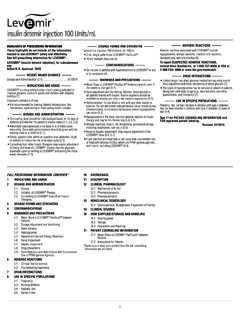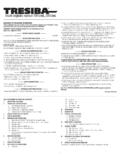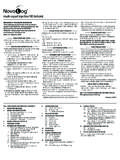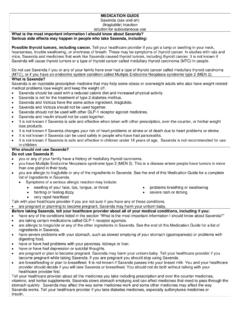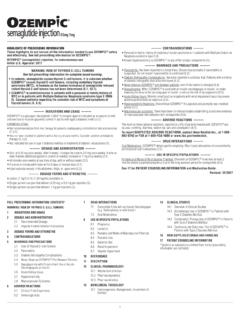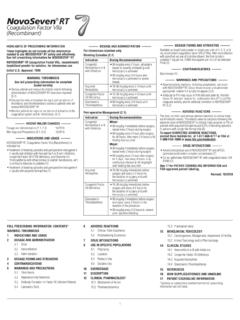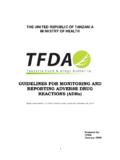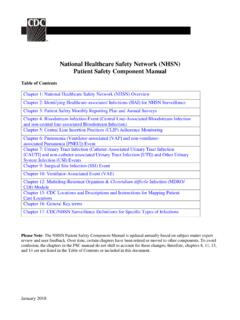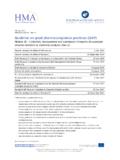Transcription of HIGHLIGHTS OF PRESCRIBING INFORMATION ...
1 1 CONTRAINDICATIONS Hypersensitivity to the active substance or to any of the excipients. (4) WARNINGS AND PRECAUTIONS Discontinue if allergic or hypersensitivity reactions occur. ( ) Monitor patients for thrombosis. ( ) Analyze for neutralizing antibodies if FXIII activity fails to reach expected levels or if reduced therapeutic effect is observed. ( ) ADVERSE REACTIONS The most common adverse reactions reported in the clinical trials ( 1%) were headache, pain in the extremities, injection site pain, D dimer increase. (6)To report SUSPECTED ADVERSE REACTIONS, contact Novo Nordisk Inc. at 1-844-873-8836 or FDA at 1-800-FDA-1088 or DRUG INTERACTIONS Do not administer TRETTEN with recombinant factor VIIa. (7)See 17 for PATIENT COUNSELING INFORMATION and FDA-approved patient : 11/2016 FULL PRESCRIBING INFORMATION : CONTENTS*1 INDICATIONS AND USAGE2 DOSAGE AND ADMINISTRATION Dose Reconstitution Administration3 DOSAGE FORMS AND STRENGTHS4 CONTRAINDICATIONS5 WARNINGS AND PRECAUTIONS Hypersensitivity Reactions Thromboembolic Risk Inhibitors6 ADVERSE REACTIONS Clinical Trials Experience7 DRUG INTERACTIONS8 USE IN SPECIFIC POPULATIONS Pregnancy Lactation Pediatric Use Geriatric Use10 OVERDOSAGE11 DESCRIPTION12 CLINICAL PHARMACOLOGY Mechanism of Action Pharmacodynamics Pharmacokinetics13 NONCLINICAL TOXICOLOGY Carcinogenesis, Mutagenesis.
2 Impairment of Fertility Animal Toxicology and/or Pharmacology14 CLINICAL STUDIES15 REFERENCES16 HOW SUPPLIED/STORAGE AND HANDLING17 PATIENT COUNSELING INFORMATION *Sections or subsections omitted from the full PRESCRIBING INFORMATION are not OF PRESCRIBING INFORMATIONT hese HIGHLIGHTS do not include all the INFORMATION needed to use TRETTEN safely and effectively. See full PRESCRIBING INFORMATION for TRETTEN .TRETTEN , Coagulation Factor XIII A-Subunit (Recombinant) For Intravenous Use. Lyophilized Powder for Solution for Injection Initial Approval: 2013 INDICATIONS AND USAGE TRETTEN , Coagulation Factor XIII A-Subunit (Recombinant), is indicated for routine prophylaxis of bleeding in patients with congenital factor XIII A-subunit deficiency. (1)TRETTEN is not for use in patients with congenital factor XIII B-subunit deficiency. (1) DOSAGE AND ADMINISTRATION For intravenous use : 35 international units per kilogram body weight once monthly to achieve a target trough level of FXIII activity at or above 10% using a validated assay.
3 ( ) Consider dose adjustment if adequate coverage is not achieved with a 35 IU/kg dose. ( ) Once reconstituted, TRETTEN may be diluted with sodium chloride to facilitate measurement of small volumes. ( )Rate: Do not exceed 1-2 mL per minute. ( ) DOSAGE FORMS AND STRENGTHS Lyophilized powder in single-use vial containing 2000 - 3125 IU of recombinant coagulation factor XIII A-subunit. After reconstitution with mL of sterile water for injection, each vial contains 667-1042 IU/mL of recombinant coagulation factor XIII , Coagulation Factor XIII A-Subunit (Recombinant)reconstitute each additional vial using the same procedure with a separate syringe. For smaller dose that requires less than the full volume in the vial, reconstituted TRETTEN may be diluted with sodium chloride to facilitate measurement of small volumes. Discard remaining product. For home administration, any such changes should be communicated by the pharmacist or healthcare provider to the patient or Administration Inspect the reconstituted TRETTEN visually for particulate matter and discoloration prior to administration.
4 Do not use if particulate matter or discoloration is observed. Administer at a rate not exceeding 1-2 mL per minute. Do not administer with other infusion solutions. Do not administer as DOSAGE FORMS AND STRENGTHSTRETTEN , Coagulation Factor XIII A-Subunit (Recombinant), is available as a white lyophilized powder in single-use vial containing nominally 2500 IU per vial (2000 3125 IU) of recombinant coagulation factor XIII A-subunit. The actual amount of TRETTEN in IU is stated on each carton and reconstitution with the provided Sterile Water for Injection, each vial contains 667-1042 IU/mL recombinant coagulation factor XIII CONTRAINDICATIONSTRETTEN is contraindicated in patients who have known hypersensitivity to the active substance or to any of the excipients [See Description (11)].5 WARNINGS AND Hypersensitivity ReactionsTRETTEN may cause allergic reactions. If signs or symptoms of anaphylaxis or hypersensitivity reactions (including urticaria, rash, tightness of the chest, wheezing, hypotension) occur, discontinue immediately and institute appropriate Thromboembolic RiskThromboembolic complications may occur.
5 Monitor patients with conditions that predispose to thrombosis for signs and symptoms of thrombosis after administration of TRETTEN . InhibitorsInhibitory antibodies may occur with TRETTEN . Patients with inhibitory antibodies may manifest as an inadequate response to treatment. If expected plasma FXIII activity levels are not attained, or if breakthrough bleeding occurs while receiving prophylaxis, perform an assay that measures FXIII inhibitory antibody ADVERSE REACTIONSThe most common adverse reactions reported in clinical trials ( 1%), were headache, pain in the extremities, injection site pain, and increase in fibrin D dimer Clinical Trials ExperienceBecause clinical trials are conducted under widely varying conditions, adverse reaction rates observed in the clinical trials of a drug cannot be directly compared to rates in the clinical trials of another drug and may not reflect the rates observed in clinical development, TRETTEN was administered to 77 subjects with congenital factor XIII A-subunit deficiency (3:2, male: female ratio) for a total of 1990 doses.
6 Fifty subjects (65%) were between the ages of 18 and 77 years (received 1338 doses), 21 subjects (27%) were between the ages of 6 and less than 18 years old (received 560 doses), and 6 subjects (8%) were less than 6 years old (received 92 doses). Subjects were exposed for up to the 77 subjects, 68 received 1979 monthly doses of 35 IU/kg of TRETTEN for routine prophylaxis of bleeding. Eleven single doses of TRETTEN have been administered to nine subjects for pharmacokinetic adverse drug reactions reported included headache, pain in the extremities, pain at the injection site, and increase in fibrin D dimer levels (without evidence of thromboembolic events).ImmunogenicityThe detection of antibody formation is highly dependent on the sensitivity and specificity of the assay. Additionally, the observed incidence of antibody (including neutralizing antibody) positivity in an assay may be influenced by several factors including assay methodology, sample handling, timing of sample collection, concomitant medications, and underlying disease.
7 For these reasons, 7. Draw back the plunger of the sterile syringe and admit a volume of mL air into the syringe. 8. Screw the syringe onto the vial adapter on the diluent vial. 9. Inject the air from the syringe into the diluent vial until resistance is felt. Then hold the syringe with the diluent vial upside down and withdraw mL water into the syringe. 10. Remove the empty diluent vial by tipping the syringe with the attached vial adapter. 11. Attach the syringe with the vial adapter to the powder vial. Hold the syringe slightly tilted with vial facing downwards. Push the plunger slowly to inject all water ( mL) into the powder vial. Do not inject the diluent directly on the TRETTEN powder to avoid foaming. 12. Gently swirl the vial until all material is dissolved. Do not shake the vial. The reconstituted TRETTEN is a clear and colorless solution. Use the reconstituted TRETTEN immediately. If not, store the solution refrigerated or at room temperature not to exceed 25 C (77 F) for up to three hours.
8 Discard after three hours. NOTE: For larger dose that requires multiple vials of TRETTEN , FULL PRESCRIBING INFORMATION1 INDICATIONS AND USAGETRETTEN , Coagulation Factor XIII A-Subunit (Recombinant), is indicated for routine prophylaxis for bleeding in patients with congenital factor XIII A-subunit is not for use in patients with congenital factor XIII B-subunit deficiency2 DOSAGE AND ADMINISTRATIONFor intravenous use Dose Treatment should be initiated under the supervision of a physician experienced in the treatment of rare bleeding disorders. The dose for routine prophylaxis for bleeding in patients with congenital factor XIII (FXIII) A-subunit deficiency is 35 international units (IU) per kilogram body weight once monthly to achieve a target trough level of FXIII activity at or above 10% using a validated assay. Consider dose adjustment if adequate coverage is not achieved with the recommended 35 IU/kg dose. A pharmacokinetic study was conducted in the FXIII congenitally deficient population evaluating five dose cohorts (2, 7, 24, 60 and 89 IU/kg) with blood sampling at , 1, 4, 8, 24, 48, 72 hours, and 7, 14, and 28 days.
9 Samples were tested for FXIII activity by a chromogenic assay and for FXIII A2B2 tetramer levels by an ELISA, as well as for other analytes. It was found that FXIII tetramer levels were proportional to the observed FXIII activity up to the point of replacement of 100% of normal FXIII activity, but there was no increase in FXIII tetramer levels at higher levels of FXIII activity. A dose of 35 IU/kg is sufficient to replace 100% of FXIII activity in this population, and higher doses may not increase the levels of tetrameric Factor ReconstitutionReconstitute only with sterile water for injection (provided with TRETTEN ). The product can be reconstituted using the vial adapter included or a needle. Water vialPowder vialPlastic cap(white)RubberstopperPlastic cap(orange)Rubberstopper Vial adapterSpikeProtectivecapProtective paperTipReconstitute using the following procedures:1. Use aseptic Wash hands before Bring TRETTEN (white lyophilized powder) and sterile water for injection (diluent) to room temperature, but not above 25 C (77 F).
10 4. Remove the plastic caps from the two Clean the rubber stoppers on the vials with sterile alcohol swabs and allow them to dry before Remove the protective paper from the vial adapter, but do not unscrew the protective cap. Attach the vial adapter to the diluent vial, without taking the vial adapter out of the protective cap. Once attached, remove the protective cap from the vial adapter by lightly squeezing the protective cap with your thumb and index finger as shown on the figure below. 3 TRETTEN , Coagulation Factor XIII A-Subunit (Recombinant)Table 3: Pharmacokinetic parameters based on steady state baseline adjusted FXIII activityParametersMean (SD)Css, max (IU/mL) ( )Css, min (IU/mL) ( )AUC(0-inf) (IU*h/mL) ( )Clearance (mL/h/kg) ( )Half-life (days) ( )Vss (mL/kg) ( )MRT (days) ( )At steady state, the pharmacokinetics of rFXIII are comparable with the single dose pharmacokinetics of (Ages 1 to < 6 Years Old)In a pharmacokinetic trial six children with congenital FXIII A-subunit deficiency on prophylaxis treatment were administered a single intravenous dose of 35 IU/kg.
